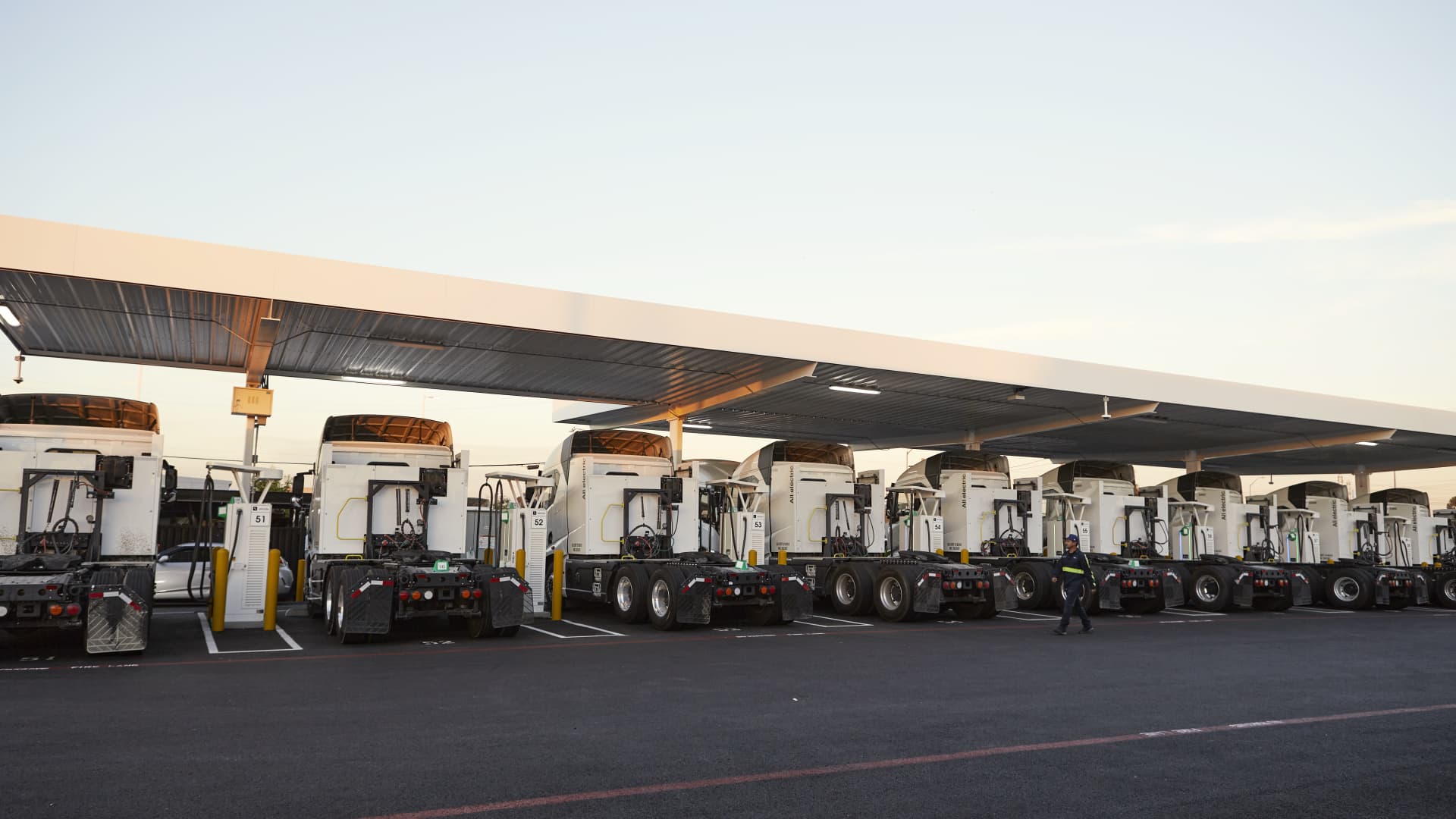One of the first EV charging stations of scale for freight trucks is opening near the major ports of Los Angeles and Long Beach, California, as the trucking market takes some limited, but significant steps to build the infrastructure required for a long-term transition to EV trucking and net-zero shipping.
Built by Sweden-based freight mobility company Einride and EV charging infrastructure company Voltera, the Lynwood Smartcharger Station along Interstate 710 has 65 chargers and the ability to charge 200 vehicles a day, initially for routes run by global shipping giant A.P. Moller-Maersk, which is also a venture investor in Einride, which was named to the 2023 CNBC Disruptor 50 list.
The Ports of Los Angeles and Long Beach handles 29% of all ocean cargo container traffic coming into the U.S.
“The launch of Einride’s first Smartcharger station in the U.S. marks a momentous stride in establishing digital, electric freight as an important enabler to a more resilient U.S. freight system,” Robert Falck, CEO and founder of Einride, said in a statement.
Founded in 2016, Einride operates one of the largest fleets of heavy duty electric trucks for large companies, including Pepsi.
Voltera, which develops, owns and operates EV infrastructure, said the site was permitted, built, electrified and operational in under 18 months. “In the world of charging infrastructure, that’s pretty remarkable,” its CEO Matt Horton said in a statement.
Einride plans to open many EV charging stations for freight trucking on the West and East coasts, though California is the only state in which there are any EV freight charging stations of scale today. In addition to the new Lynwood station, logistics company NFI announced a freight EV charging station in February that can handle up to 50 trucks, including from Volvo, in a collaboration with Electrify America and Southern California Edison. The NFI EV charging station for port drayage trucks is located at its warehouse facility in Ontario, California, also a strategic location to serve the major southern California ports.
Due to the limitations that EV truck batteries face in range, trucking companies and EV partners are focusing on drayage transportation, and the movement of goods across short distances, for use at ports and intermodal logistics facilities.
Erik Neandross, CEO of transportation consultant GNA, which works with clients on low-carbon and zero-emissions freight, said servicing 50 trucks or more is a different level of magnitude than what’s been done to date in the freight market, but he added that it is still early in the development of EV charging at scale for trucks. “We’re super early. It’s fair to say we’re in the first half of the first inning. California really is the epicenter of activity at this scale and magnitude,” he said.
California’s government has been aggressive in offering grants and incentives to build EV infrastructure, and also approved its utilities to spend $750 million on the development, which makes a significant difference in a market where there are still few EV trucks on the road or charging stations in operation, making it difficult to prove the cost competitiveness versus diesel fuel.
Government and utility spending, combined with regulations to reach net zero by 2040 — and the need among major shippers such as consumer products companies and big-box retailers, from Pepsi to Walmart, to meet their own carbon goals — create an environment in which more investment across the U.S. freight market will be occurring.
The California Air Resources Board is requiring truck manufacturers to begin phasing in available heavy-duty EV technology this year, with expectations to have all zero-emission short-haul drayage fleets by 2035. Medium and heavy trucks make up only about 4% of vehicles in the U.S., but consume more than 25% of total highway fuel and represent nearly 30% of highway carbon emissions, according to the Department of Energy.
Additional EV charging projects at ports in New York and New Jersey, as well as the Pacific Northwest, are planned.
“Now is the time to test it before the next few fleet buying cycles,” Neandross said. “There is nothing like building the infrastructure to go out and see, learn. That’s where we are today.”
The entire supply chain, from the manufacturing of products, to a container being shipped all the way from Shanghai to Chicago, will require a complex net zero equation, and shippers and freight companies are targeting everything from energy use at plants to source materials, packaging and logistics. “To get to net zero, you have to do all of it,” Neandross said. “A lot of the companies we work with have been hard at work on the non-transport side. Take Pepsi, they’ve done all they can do to put in LED lights and buy renewable energy and maximize the efficiency of production. Now it’s time to get to work on trucks and the logistics side. It’s hard, but it has to be done.”
The Environmental Protection Agency released new emissions mandates for cars and pickups this week, and the EPA is expected to soon issue new emissions requirements for medium and heavy-duty trucks, which will make alternatives to diesel engines more competitive, including both compressed natural gas-powered trucks and zero-emission EV trucks.
